airbag off Seat Toledo 2008 Owner's manual
[x] Cancel search | Manufacturer: SEAT, Model Year: 2008, Model line: Toledo, Model: Seat Toledo 2008Pages: 289, PDF Size: 9.18 MB
Page 23 of 289

Seat belts
22Seat belts protection
Passengers not wearing seat belts risk severe injuries in the
event of an accident.Properly worn seat belts hold the vehicle occupants in the correct sitting posi-
tions and substantially reduce the kinetic energy in the event of an accident.
Seat belts also help to prevent uncontrolled movements that could lead to
severe injuries. In addition, properly worn seat belts reduce the danger of
being thrown from the car.
Passengers wearing their seat belts correctly benefit greatly from the ability
of the belts to absorb kinetic energy. Th e front part of your vehicle and other
passive safety features (such as the airbag system) are also designed to
absorb the kinetic energy released in a collision. Taken together, all these
features reduce the releasing kinetic energy and consequently, the risk of
injury.
Our examples describe frontal collisions. Of course, properly worn seat belts
substantially reduce the risk of injury in all other types of accidents. This is why it is so important to fasten seat belts before every trip, even when "just
driving around the corner".
Ensure that your passengers wear their seat belts as well. Accident statistics
have shown properly that wearing seat belts is an effective mean of substan-
tially reducing the risk of injury and improving the chances of survival in a
serious accident. Furthermore, properly worn seat belts improve the protec-
tion provided by airbags in the event of
an accident. For this reason, wearing
a seat belt is required by law in most countries.
Although your vehicle is equipped with airbags, the seat belts must be
fastened and worn. The front airbags, for example, are only triggered in some
frontal accidents. The front airbags will not be triggered during minor frontal
collisions, minor side collisions, rear collisions, rolls or accidents in which the
airbag trigger threshold value in the control unit is not exceeded.
Therefore, you should always wear your seat belt and ensure that your
passengers have fastened their seat belts properly before you drive off!
Safety instructions on using seat belts
If seat belts are used correctly, they can reduce the risk of
injury in an accident.– Always wear the seat belt as described in this booklet.
– Ensure that the seat belts can be fastened at all times and are not damaged.
WARNING
•
If the seat belts are worn incorrectly or not at all, the risk of severe inju-
ries increases. The optimal protection from seat belts can be achieved only
if you use them properly.
Fig. 11 Driver wearing
the seat belt properly: is
secured by the belt in
sharp braking
Toledo_EN.book Seite 22 Dienstag, 20. Januar 2009 12:58 12
Page 28 of 289
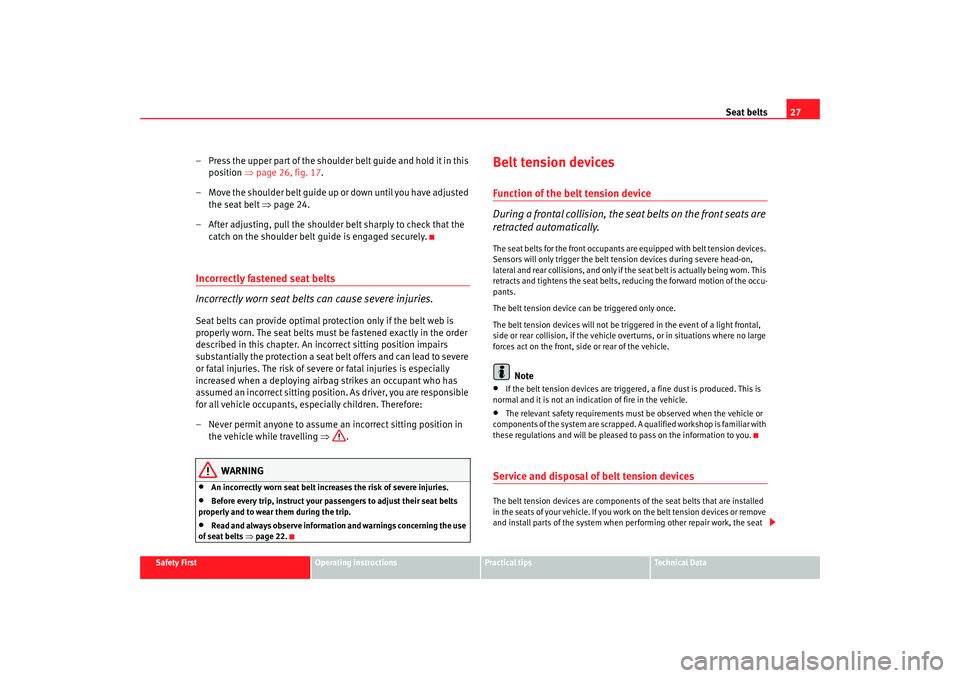
Seat belts27
Safety First
Operating instructions
Practical tips
Te c h n i c a l D a t a
– Press the upper part of the shoulder belt guide and hold it in this
position ⇒page 26, fig. 17 .
– Move the shoulder belt guide up or down until you have adjusted the seat belt ⇒page 24.
– After adjusting, pull the shoulder belt sharply to check that the catch on the shoulder belt guide is engaged securely.Incorrectly fastened seat belts
Incorrectly worn seat belts can cause severe injuries.Seat belts can provide optimal prot ection only if the belt web is
properly worn. The seat belts must be fastened exactly in the order
described in this chapter. An in correct sitting position impairs
substantially the protection a seat belt offers and can lead to severe
or fatal injuries. The risk of severe or fatal injuries is especially
increased when a deploying airbag strikes an occupant who has
assumed an incorrect sitting position. As driver, you are responsible
for all vehicle occupants, especially children. Therefore:
– Never permit anyone to assume an incorrect sitting position in
the vehicle while travelling ⇒.
WARNING
•
An incorrectly worn seat belt incr eases the risk of severe injuries.
•
Before every trip, instruct your passengers to adjust their seat belts
properly and to wear them during the trip.
•
Read and always observe information and warnings concerning the use
of seat belts ⇒page 22.
Belt tension devicesFunction of the belt tension device
During a frontal collision, the seat belts on the front seats are
retracted automatically.The seat belts for the front occupants are equipped with belt tension devices.
Sensors will only trigger the belt tension devices during severe head-on,
lateral and rear collisions, and only if th e seat belt is actually being worn. This
retracts and tightens the seat belts, reducing the forward motion of the occu-
pants.
The belt tension device can be triggered only once.
The belt tension devices will not be triggered in the event of a light frontal,
side or rear collision, if the vehicle overturns, or in situations where no large
forces act on the front, side or rear of the vehicle.
Note
•
If the belt tension devices are triggered, a fine dust is produced. This is
normal and it is not an indication of fire in the vehicle.
•
The relevant safety requirements must be observed when the vehicle or
components of the system are scrapped. A qualified workshop is familiar with
these regulations and will be pleased to pass on the information to you.
Service and disposal of belt tension devicesThe belt tension devices are components of the seat belts that are installed
in the seats of your vehicle. If you work on the belt tension devices or remove
and install parts of the system when performing other repair work, the seat
Toledo_EN.book Seite 27 Dienstag, 20. Januar 2009 12:58 12
Page 31 of 289
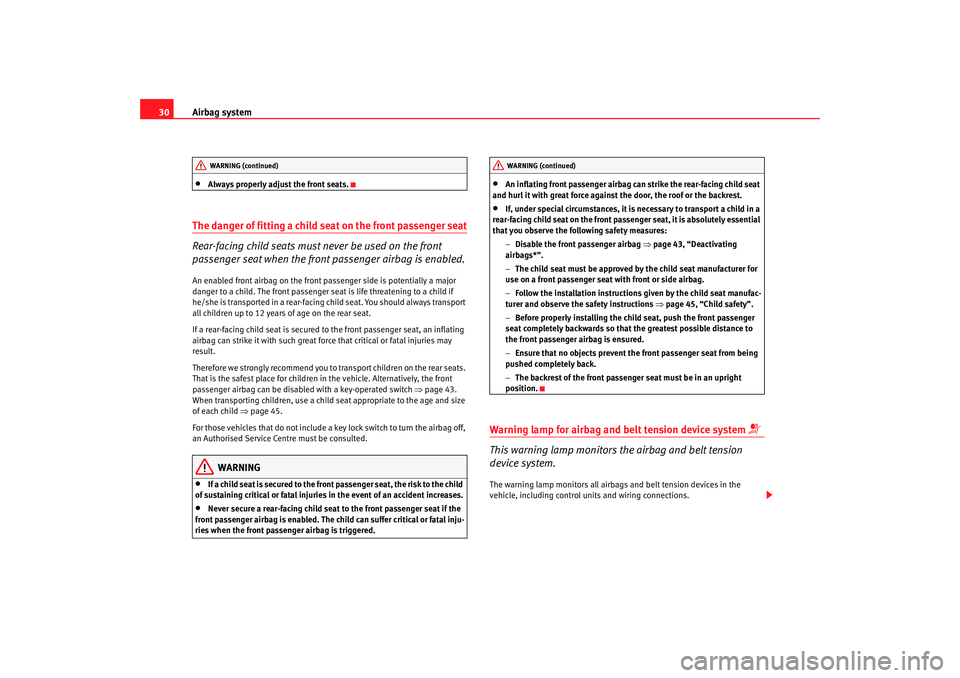
Airbag system
30•
Always properly adjust the front seats.
The danger of fitting a child seat on the front passenger seat
Rear-facing child seats must never be used on the front
passenger seat when the front passenger airbag is enabled.An enabled front airbag on the front passenger side is potentially a major
danger to a child. The front passenger seat is life threatening to a child if
he/she is transported in a rear-facing child seat. You should always transport
all children up to 12 years of age on the rear seat.
If a rear-facing child seat is secured to the front passenger seat, an inflating
airbag can strike it with such great force that critical or fatal injuries may
result.
Therefore we strongly recommend you to transport children on the rear seats.
That is the safest place for children in the vehicle. Alternatively, the front
passenger airbag can be disabled with a key-operated switch ⇒page 43.
When transporting children, use a child seat appropriate to the age and size
of each child ⇒ page 45.
For those vehicles that do not include a key lock switch to turn the airbag off,
an Authorised Service Centre must be consulted.
WARNING
•
If a child seat is secured to the fron t passenger seat, the risk to the child
of sustaining critical or fatal injuries in the event of an accident increases.
•
Never secure a rear-facing child seat to the front passenger seat if the
front passenger airbag is enabled. The child can suffer critical or fatal inju-
ries when the front passenger airbag is triggered.
•
An inflating front passenger airbag can strike the rear-facing child seat
and hurl it with great force against the door, the roof or the backrest.
•
If, under special circumstances, it is necessary to transport a child in a
rear-facing child seat on the front passenger seat, it is absolutely essential
that you observe the following safety measures:
−Disable the front passenger airbag ⇒page 43, “Deactivating
airbags*”.
− The child seat must be approved by the child seat manufacturer for
use on a front passenger seat with front or side airbag.
− Follow the installation instructions given by the child seat manufac-
turer and observe the safety instructions ⇒page 45, “Child safety”.
− Before properly installing the child seat, push the front passenger
seat completely backwards so that the greatest possible distance to
the front passenger airbag is ensured.
− Ensure that no objects prevent the front passenger seat from being
pushed completely back.
− The backrest of the front passenger seat must be in an upright
position.
Warning lamp for airbag and belt tension device system
This warning lamp monitors the airbag and belt tension
device system.The warning lamp monitors all airbag s and belt tension devices in the
vehicle, including control units and wiring connections.
WARNING (continued)
WARNING (continued)
Toledo_EN.book Seite 30 Dienstag, 20. Januar 2009 12:58 12
Page 32 of 289
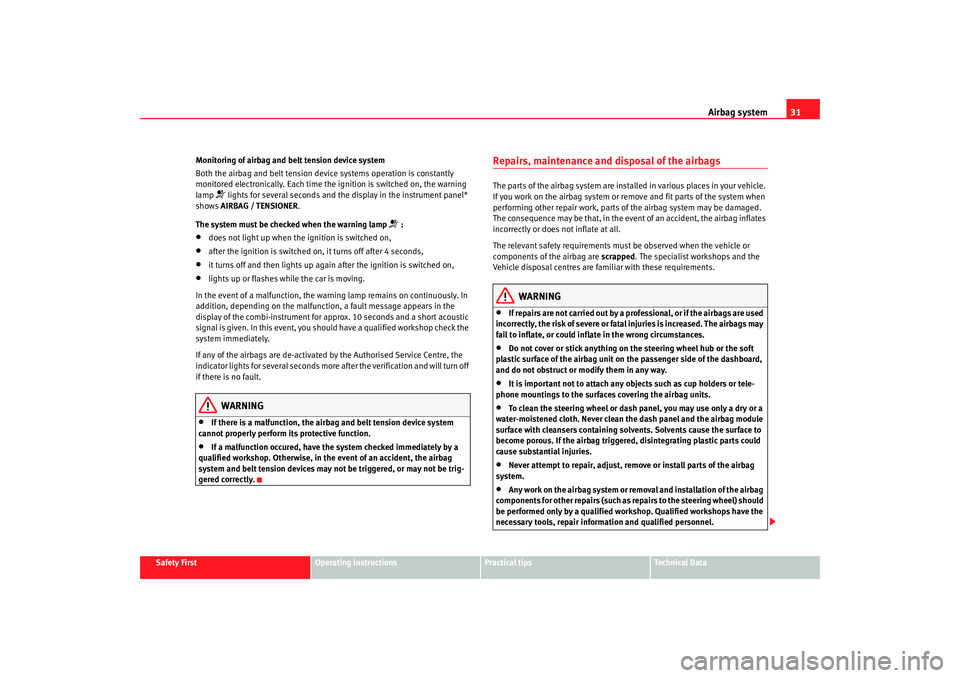
Airbag system31
Safety First
Operating instructions
Practical tips
Te c h n i c a l D a t a
Monitoring of airbag and belt tension device system
Both the airbag and belt tension device systems operation is constantly
monitored electronically. Each time the ignition is switched on, the warning
lamp
lights for several seconds and the display in the instrument panel*
shows AIRBAG / TENSIONER .
The system must be checked when the warning lamp
:
•
does not light up when the ignition is switched on,
•
after the ignition is switched on, it turns off after 4 seconds,
•
it turns off and then lights up again after the ignition is switched on,
•
lights up or flashes while the car is moving.
In the event of a malfunction, the warning lamp remains on continuously. In
addition, depending on the malfunction, a fault message appears in the
display of the combi-instrument for approx. 10 seconds and a short acoustic
signal is given. In this event, you should have a qualified workshop check the
system immediately.
If any of the airbags are de-activated by the Authorised Service Centre, the
indicator lights for several seconds more after the verification and will turn off
if there is no fault.
WARNING
•
If there is a malfunction, the airbag and belt tension device system
cannot properly perform its protective function.
•
If a malfunction occured, have the system checked immediately by a
qualified workshop. Otherwise, in the event of an accident, the airbag
system and belt tension devices may not be triggered, or may not be trig-
gered correctly.
Repairs, maintenance and disposal of the airbagsThe parts of the airbag system are installed in various places in your vehicle.
If you work on the airbag system or remove and fit parts of the system when
performing other repair work, parts of the airbag system may be damaged.
The consequence may be that, in the event of an accident, the airbag inflates
incorrectly or does not inflate at all.
The relevant safety requirements must be observed when the vehicle or
components of the airbag are scrapped. The specialist workshops and the
Vehicle disposal centres are familiar with these requirements.
WARNING
•
If repairs are not carried out by a professional, or if the airbags are used
incorrectly, the risk of severe or fatal injuries is increased. The airbags may
fail to inflate, or could inflate in the wrong circumstances.
•
Do not cover or stick anything on the steering wheel hub or the soft
plastic surface of the airbag unit on the passenger side of the dashboard,
and do not obstruct or modify them in any way.
•
It is important not to attach any objects such as cup holders or tele-
phone mountings to the surfaces covering the airbag units.
•
To clean the steering wheel or dash panel, you may use only a dry or a
water-moistened cloth. Never clean th e dash panel and the airbag module
surface with cleansers containing solvents. Solvents cause the surface to
become porous. If the airbag triggered, disintegrating plastic parts could
cause substantial injuries.
•
Never attempt to repair, adjust, remove or install parts of the airbag
system.
•
Any work on the airbag system or removal and installation of the airbag
components for other repairs (such as repairs to the steering wheel) should
be performed only by a qualified wo rkshop. Qualified workshops have the
necessary tools, repair information and qualified personnel.
Toledo_EN.book Seite 31 Dienstag, 20. Januar 2009 12:58 12
Page 34 of 289

Airbag system33
Safety First
Operating instructions
Practical tips
Te c h n i c a l D a t a
Front airbagsDescription of front airbags
The airbag system is not a substitute for the seat belts.
The front airbag for the driver is located in the steering wheel ⇒fig. 18 and
the airbag for the front passenger is located in the instrument panel
⇒ fig. 19 . Airbags are identified by the word “AIRBAG”.
In conjunction with the seat belts, the front airbag system gives the front
occupants additional protection for the head and chest in the event of a
severe frontal collision ⇒page 36, “Safety notes on the frontal airbag
system”.
In addition to their normal function of restraining the occupants, the seat
belts also hold the driver and front pas senger in a position where the airbags
can provide maximum protection in a frontal collision.
The airbag system is not a substitute for seat belts, but it is an integral part
of the vehicle's overall passive safety system. Please bear in mind that the
airbag system can only work effectively when the occupants are wearing their
seat belts correctly and have adjusted the head restraints properly. Therefore,
it is most important to wear the seat belts at all times, not only because this
is required by law in most coun tries, but also for your safety ⇒page 19,
“Brief Introduction”.
The main parts of the front airbag system are:•
an electronic control and monitoring system (control unit),
•
the two front airbags (airbag with gas generator) for the driver and front
passenger,
•
a warning lamp
in the dash panel insert ⇒page 30.
The airbag system operation is monitored electronically. The airbag warning
lamp will light up for a few seconds every time the ignition is switched on
(self-diagnosis).
There is a fault in the system if the warning lamp
•
does not light up when the ignition is switched on ⇒page 30
•
after the ignition is switched on, it turns off after 4 seconds,
•
it turns off and then lights up again after the ignition is switched on,
•
lights up or flashes while the car is moving.
Fig. 18 Driver airbag
located in steering wheelFig. 19 Front passenger
airbag located in dash
panel
Toledo_EN.book Seite 33 Dienstag, 20. Januar 2009 12:58 12
Page 35 of 289
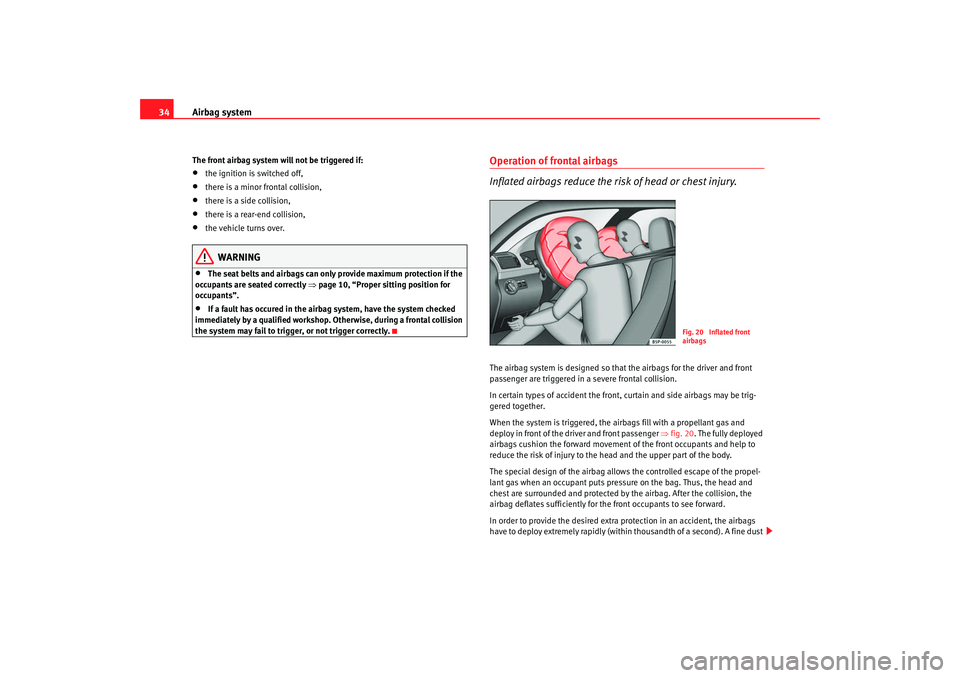
Airbag system
34The front airbag system will not be triggered if:•
the ignition is switched off,
•
there is a minor frontal collision,
•
there is a side collision,
•
there is a rear-end collision,
•
the vehicle turns over.
WARNING
•
The seat belts and airbags can only provide maximum protection if the
occupants are seated correctly ⇒ page 10, “Proper sitting position for
occupants”.
•
If a fault has occured in the airbag system, have the system checked
immediately by a qualified workshop. Otherwise, during a frontal collision
the system may fail to trigger, or not trigger correctly.
Operation of frontal airbags
Inflated airbags reduce the risk of head or chest injury.The airbag system is designed so that the airbags for the driver and front
passenger are triggered in a severe frontal collision.
In certain types of accident the front, curtain and side airbags may be trig-
gered together.
When the system is triggered, the airbags fill with a propellant gas and
deploy in front of the driver and front passenger ⇒fig. 20 . The fully deployed
airbags cushion the forward movement of the front occupants and help to
reduce the risk of injury to the head and the upper part of the body.
The special design of the airbag allows the controlled escape of the propel-
lant gas when an occupant puts pressure on the bag. Thus, the head and
chest are surrounded and protected by the airbag. After the collision, the
airbag deflates sufficiently for the front occupants to see forward.
In order to provide the desired extra protection in an accident, the airbags
have to deploy extremely rapidly (within thousandth of a second). A fine dust
Fig. 20 Inflated front
airbags
Toledo_EN.book Seite 34 Dienstag, 20. Januar 2009 12:58 12
Page 38 of 289

Airbag system37
Safety First
Operating instructions
Practical tips
Te c h n i c a l D a t a
hold the passengers on the front seats and the outer rear seats in a position
where the side airbags can provide maximum protection.
The airbag system is not a substitute for seat belts, but it is an integral part
of the vehicle's overall passive safety system. Please bear in mind that the
airbag system can only work effectively when the occupants are wearing their
seat belts. Therefore, it is most important to wear the seat belts at all times,
not only because this is required by la
w in most countries, but also for your
safety ⇒page 19, “Brief Introduction”.
The side airbag system will not be triggered if:
•
the ignition is switched off,
•
there is a minor side collision,
•
there is a frontal collision,
•
there is a rear-end collision,
•
the vehicle turns over.
The main parts of the airbag system are:
•
an electronic control and monitoring system (control unit),
•
the front side airbags in the front seats backrests and the rear side
airbags in the rear wheel housing lining,
•
a warning lamp
in the dash panel insert ⇒page 30.
The airbag system operation is monito red electronically. The airbag warning
lamp will light up for approx. 4 seconds every time the ignition is switched on
(self-diagnosis).
WARNING
•
In a side-on collision, the side air bags will not work, if the sensors do
not correctly measure the pressure incr ease on the interior of the doors,
due to air escaping through the areas with holes or openings in the door
panel.
•
Never drive the vehicle if the interior panels have been removed.
•
Never drive if the interior door pane ls have been removed or if the
panels have not been correctly fitted.
•
Never drive the vehicle if the loudspeakers in the door panels have
been removed, unless the holes left by the loudspeakers have been
correctly closed.
•
Always check that the openings are closed or covered if loudspeakers
or other equipment are fitted in the interior door panels.
•
Any work carried out to the doors should be made in a qualified author-
ised workshop.
•
The seat belts and airbags can only provide maximum protection if the
occupants are seated correctly ⇒page 10, “Proper sitting position for
occupants”.
•
If a fault has occured in the airbag system, have the system checked
immediately by a qualified workshop. Ot herwise, during a side collision,
the system may fail to trigger, or not trigger correctly.WARNING (continued)
Toledo_EN.book Seite 37 Dienstag, 20. Januar 2009 12:58 12
Page 40 of 289
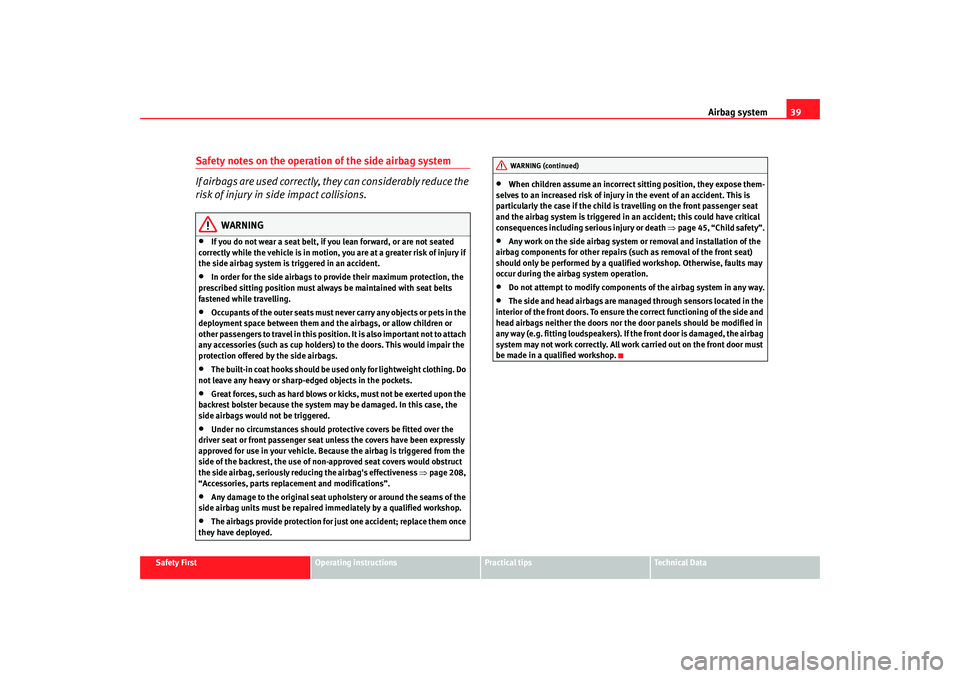
Airbag system39
Safety First
Operating instructions
Practical tips
Te c h n i c a l D a t a
Safety notes on the operation of the side airbag system
I f a i r b a g s a re u s e d c o r r e c t l y , t h e y c a n c o n s i d e ra b l y re d u c e t h e
risk of injury in side impact collisions.
WARNING
•
If you do not wear a seat belt, if you lean forward, or are not seated
correctly while the vehicle is in motion, you are at a greater risk of injury if
the side airbag system is triggered in an accident.
•
In order for the side airbags to provide their maximum protection, the
prescribed sitting position must alwa ys be maintained with seat belts
fastened while travelling.
•
Occupants of the outer seats must never carry any objects or pets in the
deployment space between them and th e airbags, or allow children or
other passengers to travel in this position. It is also important not to attach
any accessories (such as cup holders) to the doors. This would impair the
protection offered by the side airbags.
•
The built-in coat hooks should be used only for lightweight clothing. Do
not leave any heavy or sharp-edged objects in the pockets.
•
Great forces, such as hard blows or kicks, must not be exerted upon the
backrest bolster because the system may be damaged. In this case, the
side airbags would not be triggered.
•
Under no circumstances should protective covers be fitted over the
driver seat or front passenger seat unless the covers have been expressly
approved for use in your vehicle. Because the airbag is triggered from the
side of the backrest, the use of non-approved seat covers would obstruct
the side airbag, seriously reducing the airbag's effectiveness ⇒page 208,
“Accessories, parts replacement and modifications”.
•
Any damage to the original seat uphol stery or around the seams of the
side airbag units must be repaired immediately by a qualified workshop.
•
The airbags provide protection for just one accident; replace them once
they have deployed.
•
When children assume an incorrect sitting position, they expose them-
selves to an increased risk of injury in the event of an accident. This is
particularly the case if the child is travelling on the front passenger seat
and the airbag system is triggered in an accident; this could have critical
consequences including serious injury or death ⇒page 45, “Child safety”.
•
Any work on the side airbag system or removal and installation of the
airbag components for other repairs (such as removal of the front seat)
should only be performed by a qualified workshop. Otherwise, faults may
occur during the airbag system operation.
•
Do not attempt to modify components of the airbag system in any way.
•
The side and head airbags are managed through sensors located in the
interior of the front doors. To ensure the correct functioning of the side and
head airbags neither the doors nor the door panels should be modified in
any way (e.g. fitting loudspeakers). If the front door is damaged, the airbag
system may not work correctly. All work carried out on the front door must
be made in a qualified workshop.WARNING (continued)
Toledo_EN.book Seite 39 Dienstag, 20. Januar 2009 12:58 12
Page 41 of 289

Airbag system
40Curtain airbagsDescription of curtain airbags
The airbag system is not a substitute for the seat belts.The curtain airbags are located on both sides in the interior above the doors
⇒ fig. 24 and are identified with the text “AIRBAG”.
In conjunction with the seat belts, the curtain airbag system gives the occu-
pants additional protection for the head and upper body in the event of a
severe side collision ⇒ page 41, “Safety notes on the operation of the
curtain airbag system”.
The airbag system is not a substitute for seat belts, but it is an integral part
of the vehicle's overall passive safety system. Please bear in mind that the
airbag system can only work effectively when the occupants are wearing their
seat belts correctly and have adjusted th e head restraints properly. Therefore,
it is most important to wear the seat belts at all times, not only because this is required by law in most countries, but also for your safety
⇒page 19,
“Brief Introduction”.
The main parts of the curtain airbag system are:
•
an electronic control and monitoring system (control unit),
•
the curtain airbags (airbags with ga s generator) for the driver, front
passenger and passengers on the rear seats,
•
a warning lamp
in the dash panel insert ⇒ page 30.
The airbag system operation is monitored electronically.
The curtain airbag system will not be triggered
•
the ignition is switched off,
Fig. 24 Location of left curtain airbag
Toledo_EN.book Seite 40 Dienstag, 20. Januar 2009 12:58 12
Page 44 of 289

Airbag system43
Safety First
Operating instructions
Practical tips
Te c h n i c a l D a t a
Deactivating airbags*Disabling front passenger airbag
If you fit a rear-facing child seat to the front passenger seat,
the front passenger airbag must be de-activated.
When the passenger airbag is deactivated, this means that only the
frontal airbag is deactivated. All the other airbags in the vehicle
remain functional.
Disabling front passenger airbag
– Switch the ignition on.
– Turn the ignition switch in the key operated switch in the glove box to the position OFF ⇒ fig. 26 .
– Check that the warning lamp “OFF” on the instrument panel ⇒fig. 27 remains lit when the ignition is switched on ⇒.
Enabling front passenger airbag
– Switch the ignition on.
– Turn the ignition switch in the key-operated switch in the glove box to the position ON ⇒ fig. 26 .
Fig. 26 In the glovebox:
key for enabling and disa-
bling front passenger
airbag
Fig. 27 Warning lamp for
deactivated passenger
airbag in centre console
Toledo_EN.book Seite 43 Dienstag, 20. Januar 2009 12:58 12